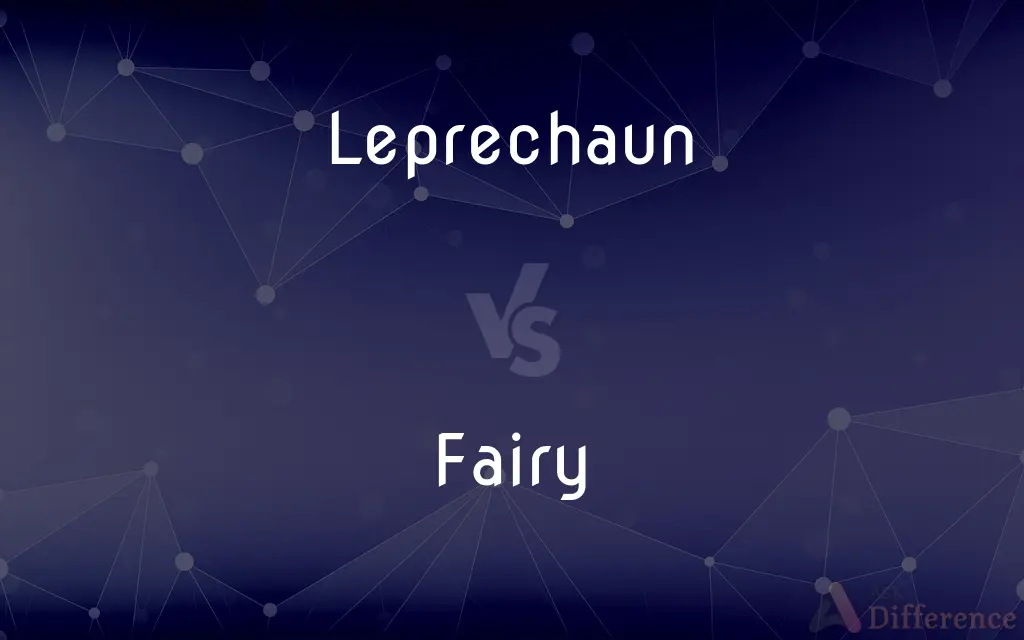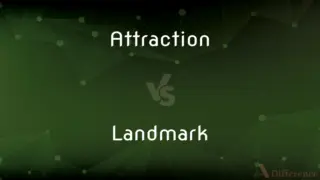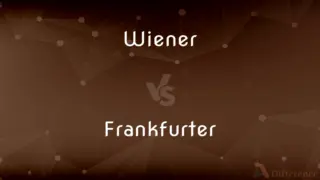Leprechaun vs. Fairy — What's the Difference?
By Fiza Rafique & Urooj Arif — Updated on March 30, 2024
A leprechaun is a type of fairy in Irish folklore known for mischief and guarding treasure, while fairies broadly represent a range of magical beings with diverse powers and roles in various mythologies.

Difference Between Leprechaun and Fairy
Table of Contents
ADVERTISEMENT
Key Differences
Leprechauns are often depicted as solitary creatures, cobblers by trade, who possess a hidden pot of gold. While fairies, encompassing a wide variety of beings, are generally associated with nature, enchantment, and sometimes trickery, existing in numerous cultures' folklore.
The legend of the leprechaun is deeply rooted in Irish folklore, primarily known for their cunning and elusive nature, aiming to protect their treasures. On the other hand, fairies can be found in a multitude of cultural stories worldwide, from the benign to the mischievous, and their characteristics can vary widely from one tradition to another.
Leprechauns are typically portrayed as male figures, often dressed in green, symbolizing their connection to Ireland and its mythology. Whereas fairies are depicted in a variety of forms, from ethereal and beautiful to grotesque and eerie, without a strict attachment to a specific appearance or gender.
One of the unique aspects of leprechauns is their association with a specific object: the pot of gold at the end of the rainbow, which they guard diligently. Fairies, however, are often linked with natural elements and phenomena, such as forests, flowers, or even specific emotions, rather than material treasures.
In terms of interaction with humans, leprechauns are known for their trickery to protect their gold or lead humans astray. Fairies, on the other hand, might interact with humans in a wider range of ways, from granting wishes to cursing or blessing individuals, depending on the story or tradition.
ADVERTISEMENT
Comparison Chart
Origin
Irish folklore
Various mythologies worldwide
Main Association
Pot of gold, cobbling
Nature, enchantment, various roles
Appearance
Typically male, often in green
Diverse, ranging from beautiful to eerie
Behavior
Solitary, mischievous, secretive
Can be benign or mischievous, varies widely
Interaction with Humans
Trickery to protect their treasure or lead astray
Ranges from granting wishes to cursing, depending on lore
Compare with Definitions
Leprechaun
A mythical Irish fairy known for mischief and guarding treasure.
He searched for the leprechaun's pot of gold at the rainbow's end.
Fairy
Guardians of the natural world in many stories.
The ancient oak was said to be protected by a circle of fairies.
Leprechaun
Associated with St. Patrick's Day celebrations.
Dressed as leprechauns, they joined the parade with great enthusiasm.
Fairy
Appear in various forms and sizes in mythology.
Tales spoke of fairies, some as tiny lights, others as majestic beings.
Leprechaun
Portrayed as small, elderly men in green coats.
The story described a leprechaun with a beard and a green hat hiding his coins.
Fairy
Can be benevolent or malevolent towards humans.
The fairies rewarded the kind-hearted girl with eternal happiness.
Leprechaun
Traditionally a cobbler in folklore.
The leprechaun mended shoes as a disguise for his true magical nature.
Fairy
Supernatural beings with magical powers, often connected to nature.
The fairy glided over the garden, blessing each bloom with dew.
Leprechaun
Believed to grant three wishes in exchange for their freedom.
She dreamt of catching a leprechaun to have her wishes granted.
Fairy
Feature in numerous folktales and literary works.
She read a story about fairies living in an enchanted forest.
Leprechaun
A leprechaun (Irish: leipreachán/luchorpán) is a diminutive supernatural being in Irish folklore, classed by some as a type of solitary fairy. They are usually depicted as little bearded men, wearing a coat and hat, who partake in mischief.
Fairy
A fairy (also fay, fae, fey, fair folk, or faerie) is a type of mythical being or legendary creature found in the folklore of multiple European cultures (including Celtic, Slavic, German, English, and French folklore), a form of spirit, often described as metaphysical, supernatural, or preternatural. Myths and stories about fairies do not have a single origin, but are rather a collection of folk beliefs from disparate sources.
Leprechaun
In Irish folklore, a mischievous elflike creature or fairy who grants wishes or reveals the location of hidden treasure when captured.
Fairy
A small imaginary being of human form that has magical powers, especially a female one
Fairy gold
She believed she had had fairies at the bottom of her garden
Leprechaun
(Irish folklore) One of a race of elves that can reveal hidden treasure to those who catch them.
Fairy
A Central and South American hummingbird with a green back and long tail.
Leprechaun
A small mischevous elf or spirit in Irish folklore; it is often depicted in literature as a dwarfish bearded old man; - legend tells that if a leprechaun is captured, he will reveal the location of his hidden pot of gold.
Fairy
An imaginary being in human form, depicted as clever, mischievous, and possessing magical powers.
Leprechaun
A mischievous elf in Irish folklore
Fairy
Offensive Slang Used as a disparaging term for a gay man.
Fairy
The realm of faerie; enchantment, illusion.
Fairy
A mythical being with magical powers, known in many sizes and descriptions, although often depicted in modern illustrations only as a small sprite with gauze-like wings, and revered in some modern forms of paganism.
Fairy
An enchantress, or creature of overpowering charm.
Fairy
A member of two species of hummingbird in the genus Heliothryx.
Fairy
A legendary Chinese immortal.
Fairy
Like a fairy; fanciful, whimsical, delicate.
Fairy
Enchantment; illusion.
The God of her has made an end,And fro this worlde's fairyHath taken her into company.
Fairy
The country of the fays; land of illusions.
He [Arthur] is a king y-crowned in Fairy.
Fairy
An imaginary supernatural being or spirit, supposed to assume a human form (usually diminutive), either male or female, and to meddle for good or evil in the affairs of mankind; a fay. See Elf, and Demon.
The fourth kind of spirit [is] called the Fairy.
And now about the caldron sing,Like elves and fairies in a ring.
Fairy
An enchantress.
No goblin or swart fairy of the mineHath hurtful power over true virginity.
Fairy
Of or pertaining to fairies.
Fairy
Given by fairies; as, fairy money.
Fairy
Small, human in form, playful, having magical powers
Common Curiosities
What is a leprechaun?
A leprechaun is a type of fairy in Irish folklore, known for being a solitary cobbler and guarding a hidden pot of gold.
Are leprechauns considered good or evil?
Leprechauns are neither strictly good nor evil; they are mischievous beings known for their trickery.
How do leprechauns differ from other fairies?
Leprechauns are specifically from Irish folklore and are known for their mischief and treasure-guarding, unlike fairies, which have a broader range of characteristics and origins.
Can fairies grant wishes?
In some stories, fairies have the power to grant wishes to humans, though this trait is not universal.
What are fairies?
Fairies are magical beings found in various mythologies, often associated with nature and possessing diverse powers.
Do fairies interact with humans?
Yes, fairies can interact with humans in many ways, from helping to hindering them, depending on the lore.
What happens if you catch a leprechaun?
Legend has it that catching a leprechaun compels him to grant three wishes or reveal the location of his pot of gold.
Can fairies and leprechauns appear in different forms?
Yes, both can appear in various forms, but leprechauns are traditionally seen as male and dressed in green, while fairies' appearances vary widely.
What is the significance of a leprechaun's pot of gold?
The pot of gold symbolizes wealth and the lengths to which leprechauns will go to protect their treasure from humans.
Is there a specific habitat for leprechauns and fairies?
Leprechauns are often linked to rural areas and the countryside in Ireland, while fairies are believed to inhabit natural settings like forests and gardens.
Do children believe in leprechauns and fairies?
Many children are fascinated by the magical and whimsical nature of leprechauns and fairies, often featuring in children's stories and myths.
Are fairies and leprechauns part of the same folklore?
Leprechauns are a type of fairy within Irish folklore, but the concept of fairies extends beyond any single tradition, appearing in various cultures worldwide.
How can one see a leprechaun or fairy?
According to folklore, seeing a leprechaun or fairy requires luck and often happens unexpectedly, in natural settings.
Are leprechauns part of modern celebrations?
Yes, leprechauns have become symbols of St. Patrick's Day and Irish culture, often featured in parades and decorations.
What role do fairies play in literature?
Fairies have been central to many literary works, embodying themes of magic, mystery, and a connection to nature.
Share Your Discovery

Previous Comparison
Attraction vs. Landmark
Next Comparison
Wiener vs. FrankfurterAuthor Spotlight
Written by
Fiza RafiqueFiza Rafique is a skilled content writer at AskDifference.com, where she meticulously refines and enhances written pieces. Drawing from her vast editorial expertise, Fiza ensures clarity, accuracy, and precision in every article. Passionate about language, she continually seeks to elevate the quality of content for readers worldwide.
Co-written by
Urooj ArifUrooj is a skilled content writer at Ask Difference, known for her exceptional ability to simplify complex topics into engaging and informative content. With a passion for research and a flair for clear, concise writing, she consistently delivers articles that resonate with our diverse audience.
















































